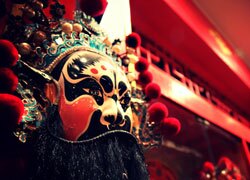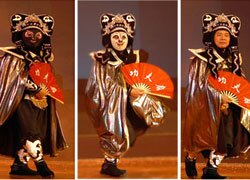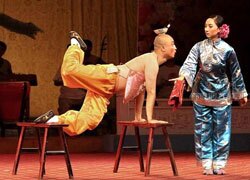Sichuan Opera
Chinese opera, an art form that dates back as far as the Three Kingdoms period (200 AD), is a diverse style of music. As an entertainment, you could see any of the five forms and get a vastly different experience. Each employs specific makeup or masking, lyric style and acting methods. Of the five, Sichuan opera is the youngest, starting around 1700. Despite being the most recently developed, Sichuan opera is complex in form as well as beautiful to behold. Thus it also is one of top things to do in Chengdu.
History
 Chengdu is the birthplace of Sichuan opera. It is also still the best place to see it. There are opera houses all over the region but, Chengdu features more of them and more variety in them. Today’s modern opera houses, though, are a far cry from the locales where it originated.
Chengdu is the birthplace of Sichuan opera. It is also still the best place to see it. There are opera houses all over the region but, Chengdu features more of them and more variety in them. Today’s modern opera houses, though, are a far cry from the locales where it originated.
Unlike the operatic music of Northern China, Sichuan opera rose out of folk traditions. Combining rural customs, dialects, songs, and stories, what was then called Canjun opera, started being performed during the Three Kingdoms era. Each province at the time, had its own vocal style or music form.Canjun combined those and, eventually, lent the Sichuan dialect to performances.
Each of the major operatic styles (Zaju, Kunqu, Bangzi, Pihuang and Jinling) merged in this transition. The combination created very popular performances that brought to the stage a variety of techniques and musics. You could enjoy an opera in someone’s yard, a music hall, a fair, or even the occasional theater. It was truly everywhere and the music of the people.
A reform movement got its start in the beginning of the 20th century. With the Sanqing Opera Association, Kang Zhilin’s leadership was responsible for moving the Sichuan opera out of diverse settings and into tea houses and more modern theaters. All five operatic forms were permanently combined and stayed unified.
Although the Cultural Revolution was devastating for much of China, including its art, Sichuan opera rebounded easily afterward. The economic reform of the late 1970’s helped, as did the continued evolution of theatrical technology and technique. Today’s opera patron gets to see the best of the old and the new in Chinese opera.
Subjects
 Sichuan opera stands out for its variety of stories. Some say there is an endless range, drawn from its diverse background and the broad culture of rural China. Comedic operas are a big favorite and feature the “trick performance.” The “trick performance” can beacrobatic feats or part of the technique of the play itself, which we discuss further below.
Sichuan opera stands out for its variety of stories. Some say there is an endless range, drawn from its diverse background and the broad culture of rural China. Comedic operas are a big favorite and feature the “trick performance.” The “trick performance” can beacrobatic feats or part of the technique of the play itself, which we discuss further below.
Visitors to the Sichuan opera can see folklore acted out in Tales of White Snake, one of the estimated 800 song tales, a tragedy or a love story. We suggest that you contact the theater to see what plays are being performed during your visit to Chengdu and choose the one(s) that appeal to you most.
Three Types of Face Changes
 Face changes are a big part of the magic of Sichuan opera. The actors in these plays almost instantaneously change their faces. Doing so conveys different moods, meaning that the switches have to be not only fast but, undetectable to the audience. It’s said that the Chinese people developed this art to scare wild animals away but, these days, it serves to draw more and more visitors to the opera.
Face changes are a big part of the magic of Sichuan opera. The actors in these plays almost instantaneously change their faces. Doing so conveys different moods, meaning that the switches have to be not only fast but, undetectable to the audience. It’s said that the Chinese people developed this art to scare wild animals away but, these days, it serves to draw more and more visitors to the opera.
There are actually 3 ways actors use this technique. The first, Wiping Mask, uses cosmetics. Actors put the face paint on in a way that lets them change their faces. This grease paint is removed at the key moment. So, depending on what part of the face the actor wants to change, he or she will put the paint on the forehead, the eyebrows, cheeks or nose. The change occurs by removing the paint while on stage.
The most challenging face change is called the Pulling Mask. This requires thinly cut masks that are painted to match the emotion. Each mask is tied with silk thread to a part of the costume. While acting, the performer wears all the masks, pasted to his or her face. The masks are removed with the emotional changes of the play. Actors have to be very skilled to perform this face change.
The threads are sewn to their costumes. So, they have to use physical movement to disguise how they’re switching masks. Such quick motion can be covered with the dance moves of the piece. These days, technology steps in and helps with careful lighting movements or even the use of lasers. None of that, though, alleviates the pressure on the actors. They must make each change perfectly to protect the illusion.
While the Wiping Mask uses grease paint or liquid cosmetics, the Blowing Mask uses powders. In a puff of breath, the actor changes the color of his face, using silver, skin-tone or gold powder. At the start of the play, a little box is set on the stage. This box holds all the powders needed. At the moment the change needs to occur, he or she will kiss the ground. While posed in this way, they blow into the box. This releases the powder and it is blown onto his or her face. All of this occurs in only seconds while the actor’s breath is held and eyes are closed. By the time they stand back up, the face of the actor is a different color, showing the required emotion.
Where to Watch Sichuan Opera
 Booking tickets to see Sichuan opera can take you all over Chengdu. However, you can simplify the task by heading to the Shufengyayun Sichuan Opera House. This theater hosts a performance each evening. Starting at 8pm, you can see traditional Sichuan opera, sample tea and view some local craftsmanship.
Booking tickets to see Sichuan opera can take you all over Chengdu. However, you can simplify the task by heading to the Shufengyayun Sichuan Opera House. This theater hosts a performance each evening. Starting at 8pm, you can see traditional Sichuan opera, sample tea and view some local craftsmanship.
The Shufengyayun has been a cultural draw for the last century. Offering both travelers and residents the chance to see traditional Chinese art forms, it serves as a repository, of a sort. In its efforts to showcase China’s talent, history and culture, The Shufengyayun(蜀风雅韵) helps to preserve the country’s history and to share it with new audiences each day.
Tips before you go



